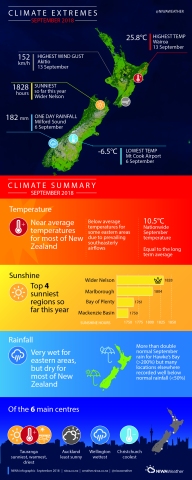A wet start to spring for some but dry for most
|
Temperature
|
Mean temperatures for September were near average (i.e. -0.50 to +0.50°C) across most of the country. Below average mean temperatures (i.e. -0.51 to -1.20°C) were restricted to eastern locations in Canterbury and Marlborough, as well as part of Northland, and other isolated patches in the North Island. |
|
Rainfall |
Rainfall was above normal (i.e. 120-149% of normal) to well above normal (i.e. >149% of normal) for eastern parts of the North Island as well as around Otago and Southland. Northland and Wellington experienced near normal rainfall totals (i.e. 80-119% of normal) while much of the country experienced below normal (50-79% of normal) or well below normal (<50% of normal) rainfall levels. |
|
Soil Moisture |
As of 1 October 2018, soil moisture levels were above normal for the time of year for much of Otago, particularly toward the coast, as well as around coastal Gisborne. Drier than normal soil moistures were present from Nelson through to northern Canterbury and through much of the central and southern North Island. Soil moisture levels were generally near normal for the time of year across the rest of the country. |
Overview
For the month as whole, September mean sea level pressure was lower than normal over and to the northeast of the North Island and higher than normal over and to the west of the South Island, resulting in more southeasterly winds than normal over the country.
Rainfall during September was above normal (i.e. 120-149% of normal) to well above normal (i.e. >149% of normal) for eastern parts of the North Island as well as Otago, Banks Peninsula, and much of Southland. In contrast, most of the remaining locations throughout the country experienced below normal (50-79% of normal) or well below normal (<50% of normal) rainfall levels except for parts of Northland and Wellington which experienced near normal rainfall totals.
Near average temperatures (i.e. -0.50 to +0.50°C of the September average) were experienced across most of the country while limited areas in the Far North as well as coastal parts of Canterbury and Marlborough observed below average temperatures (i.e. -0.51 to -1.20°C of the September average).
The nationwide average temperature in September 2018 was 10.5°C (the same as the 1981-2010 September average from NIWA’s seven station temperature series which begins in 1909).

Further highlights
- The highest temperature was 25.8°C, observed at Wairoa on 13 September.
- The lowest temperature was -6.5°C, observed at Mt Cook Airport on 6 September.
- The highest 1-day rainfall was 182 mm, recorded at Milford Sound on 29 September.
- The highest wind gust was 152 km/h, observed at Akitio on 13 September.
- Of the six main centres in September 2018, Christchurch was the coolest, Wellington was the wettest, Tauranga was the warmest, driest and sunniest, and Auckland was the least sunny.
- Of the available, regularly reporting sunshine observation sites, the sunniest four regions in 2018 so far (1 January – 30 September) are Wider Nelson (1828 hours), Marlborough (1804 hours), Bay of Plenty (1761 hours) and Mackenzie Basin (1750 hours).
- Of the available, regularly reporting low elevation rainfall sites, the two wettest locations in 2018 so far (1 January – 30 September) are Milford Sound (5569 mm) and Arthur’s Pass (3554 mm). The two driest locations in 2018 so far are Alexandra (328 mm) and Clyde (364 mm).
Download
- September 2018 Climate Summary information [480KB PDF]
- September 2018 Climate Statistics [PDF 70KB]
Contact
Petra Pearce, Climate Scientist NIWA Auckland
Tel. 09 375 2052
